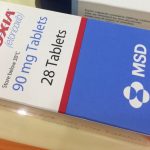Moxicam Tablets: Uses, Dosage, Side Effects, Interaction

What is Moxicam tablets used for?
Moxicam oral tablet is an Australian brand of meloxicam, a COX-2 inhibiting nonsteroidal anti-inflammatory drugs (NSAIDs). It is used to treat rheumatoid arthritis and painful osteoarthritis in adults. It helps with these conditions by relieving pain and reducing swelling and inflammation. NSAIDs work by blocking a response to injury in the body that leads to inflammation and pain.
Moxicam is also used to relieve the pain, tenderness, swelling, and stiffness caused by juvenile rheumatoid arthritis (a type of arthritis that affects children) in children 2 years of age and older.
How should I take Moxicam 15 and Moxicam 7.5mg?
Moxicam comes in 7.5mg and 15mg tablets. The standard dosage of meloxicam is 7.5 mg taken once per day, with a maximum daily dosage of 15 mg. For children with juvenile rheumatoid arthritis, the standard dosage is 0.125 mg/kg per day, with a maximum dosage of 7.5 mg per day.
Typical dosing for Moxicam Tablets:
• Rheumatoid arthritis and osteoarthritis: Take 7.5 mg to 15 mg by mouth once a day. Do not take more than 15 mg a day.
• Juvenile rheumatoid arthritis: Take 7.5 mg by mouth once a day. Do not take more than 7.5 mg a day.
Capsules:
• Rheumatoid arthritis and osteoarthritis: Take 5 mg to 10 mg by mouth once a day. Do not take more than 10 mg a day.
Moxicam can take up to two weeks to start working in full effect. Some changes to pain, swelling, tenderness, or stiffness may be noticeable within 24 to 72 hours, but it might take longer to notice a large difference in pain levels.
The use of this medication should be limited to the lowest effective dose for the shortest period of time needed.
Many things can affect the dose of medication that a person needs, such as body weight, other medical conditions, and other medications. If your doctor has recommended a dose different from the ones listed here, do not change the way that you are taking the medication without consulting your doctor.
What side effects can Moxicam 15 and Moxicam 7.5mg cause?
Moxicam may cause side effects. Tell your doctor if any of these symptoms are severe or do not go away:
• diarrhea
• gas
• sore throat
Some side effects can be serious. If you experience any of the following symptoms, call your doctor immediately. Do not take any more Moxicam until you speak to your doctor:
• fever
• blisters
• rash
• skin blisters or peeling
• hives
• itching
• swelling of the eyes, face, tongue, lips, or throat
• difficulty breathing or swallowing
• hoarseness
• pale skin
• fast heartbeat
• shortness of breath or difficulty breathing
• unexplained weight gain,
• swelling in the abdomen, ankles, feet, or legs
• nausea
• excessive tiredness
• lack of energy
• yellowing of the skin or eyes
• pain in the right upper part of the stomach
• flu-like symptoms
• cloudy, discolored, or bloody urine
• back pain
• difficult or painful urination
Moxicam may cause other side effects. Call your doctor if you have any unusual problems while taking this medication.
If you experience a serious side effect, you or your doctor may send a report to the Food and Drug Administration’s (FDA) MedWatch Adverse Event Reporting program online (http://www.fda.gov/Safety/MedWatch) or by phone (1-800-332-1088).
What happens if I miss a dose?
Take the missed dose as soon as you remember. Skip the missed dose if it is almost time for your next scheduled dose. Do not take extra medicine to make up for the missed dose.
What happens if I overdose?
Seek emergency medical attention or call the Poison Help line at 1-800-222-1222.
What to avoid
Avoid alcohol. Heavy drinking can increase your risk of stomach bleeding.
Moxicam 15 and Moxicam 7.5mg may interact with other medications
Moxicam 15 and Moxicam 7.5mg oral tablet can interact with several other medications. Different interactions can cause different effects. For instance, some can interfere with how well a drug works, while others can cause increased side effects.
Below is a list of medications that can interact with Moxicam. This list does not contain all drugs that may interact with Moxicam.
Before taking Moxicam, be sure to tell your doctor and pharmacist about all prescription, over-the-counter, and other drugs you take. Also tell them about any vitamins, herbs, and supplements you use. Sharing this information can help you avoid potential interactions.
If you have questions about drug interactions that may affect you, ask your doctor or pharmacist.
Antidepressants and anxiety drugs
Taking Moxicam with certain antidepressant and anxiety medications raises your risk of bleeding. Examples of these drugs include:
• selective serotonin reuptake inhibitors, such as citalopram
• selective serotonin and norepinephrine reuptake inhibitors, such as venlafaxine
Corticosteroids
Taking Moxicam with corticosteroids can increase your risk of stomach ulcers or bleeding. Examples of these drugs include:
• prednisone
• dexamethasone
Cancer drug
Taking pemetrexed with Moxicam can increase your risk for infection, kidney problems, and stomach issues.
Transplant drug
Taking cyclosporine with Moxicam can increase the levels of cyclosporine in your body, causing kidney problems. If you take these drugs together, your doctor should monitor your kidney function.
Disease-modifying antirheumatic drug
Taking methotrexate with Moxicam can increase the levels of methotrexate in your body. This can result in kidney problems and an increased risk of infection.
Anticoagulant/blood thinner
Taking warfarin with Moxicam increases your risk of stomach bleeding.
Bipolar disorder medication
Taking lithium with Moxicam can cause amounts of lithium in your blood to increase to dangerous levels. Symptoms of lithium toxicity may include tremors, excessive thirst, or confusion. If you take these drugs together, your doctor may monitor your lithium levels.
Blood pressure drugs
Taking these medications with Moxicam may reduce the blood-pressure-lowering effects of these drugs. Examples of these drugs include:
• angiotensin receptor blockers (ARBs), such as candesartan and valsartan
• angiotensin-converting enzyme (ACE) inhibitors, such as benazepril and captopril
• beta blockers, such as propranolol and atenolol
Diuretics (water pills)
Taking certain diuretics with Moxicam can decrease the effect of these drugs. Examples of these diuretics include:
• hydrochlorothiazide
• furosemide
Nonsteroidal anti-inflammatory drugs (NSAIDs)
Moxicam is an NSAID. Combining it with other NSAIDs may increase your risk of side effects, such as stomach bleeding or ulcers. Examples of NSAIDs include:
• aspirin
• ibuprofen
• naproxen
• etodolac
• diclofenac
• fenoprofen
• ketoprofen
• tolmetin
• indomethacin





